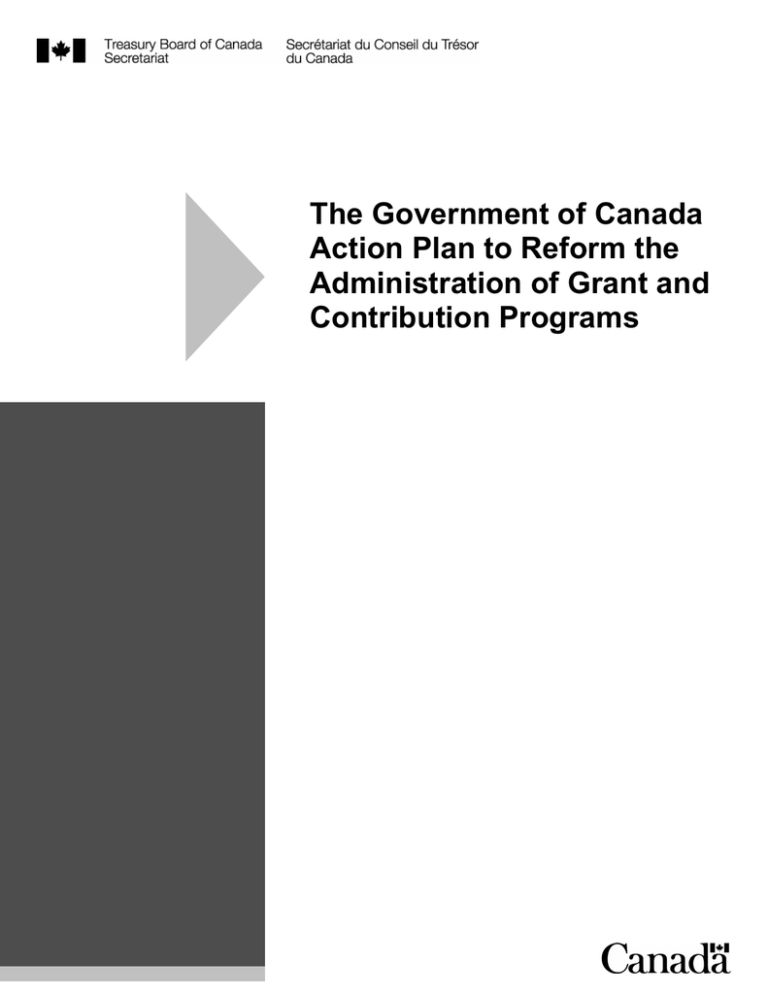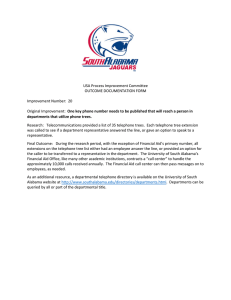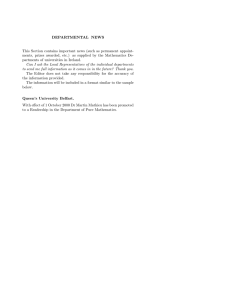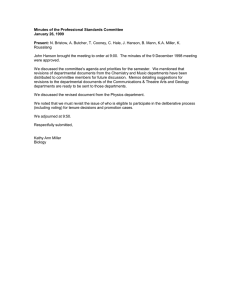The Government of Canada Action Plan to Reform the d
advertisement

The Government of Canada Action Plan to Reform the Administration of Grant and Contribution Programs © Her Majesty the Queen in Right of Canada, represented by the President of the Treasury Board, 2008 Catalogue No. ISBN This document is available on the Treasury Board of Canada Secretariat’s website at http://www.tbs-sct.gc.ca. This document is also available in alternative formats on request. Table of Contents A Message from the President of the Treasury Board ................................ 1 Background ........................................................................................ 2 Gs and Cs Action Plan .......................................................................... 3 Key facts ........................................................................................ 3 Policy Reform .................................................................................. 3 Departmental Action Plans................................................................. 4 Horizontal Enablers .......................................................................... 6 Looking Forward .................................................................................. 8 i A Message from the President of the Treasury Board It gives me great pleasure to introduce the Government of Canada’s Action Plan to Reform the Administration of Grant and Contribution Programs (Gs and Cs). The Plan outlines the activities that the government will undertake over the next three years to improve the management of Gs and Cs, as well as the expected results. The Plan is the outcome of many months of hard work by individuals and organizations both inside and outside the government, and I want to particularly acknowledge the invaluable advice provided by the recipient community. There is no question that federal Gs and Cs are a key tool used by the government to deliver on its priorities. It is also clear that, if we want to achieve results and better meet the needs of Canadians, it is essential to change how we do business. While Gs and Cs need to be managed more efficiently, the government must ensure its accountability for these programs. In February 2007, an Independent Blue Ribbon Panel provided recommendations aimed at simplifying the administration of Gs and Cs while, at the same time, strengthening accountability and risk-based approaches for managing the programs. Through the development of the Action Plan and other work that has taken place over the past year, we are meeting the commitments made by the government in response to the Panel’s key recommendations. With this plan, recipients, stakeholder organizations and federal program administrators will be able to see our progress, and more importantly, our next steps and our commitment to engage them in the process. The last year has seen much activity, and a solid foundation has been laid for systemic change. This kind of change takes time, and there is still much work to be done. However, I believe that the Action Plan will serve as a vital roadmap to guide us over the next few years. Sincerely, The Honourable Vic Toews, P.C., M.P. President of the Treasury Board 1 Background Each year, the Government of Canada transfers approximately $27 billion to individuals and organizations through more than 800 grant and contribution programs (Gs and Cs) that provide real benefits for Canadians. These programs promote Canada’s economic and social development, and enrich the quality of life we enjoy as a nation. Recipients of federal Gs and Cs include: • not-for-profit voluntary organizations that help make Canada’s communities places where people want to live and raise their families; • service providers that assist thousands of people with challenges in their lives; • small businesses and industry associations working to make Canada more globally competitive; • First Nations providing essential services to Aboriginal communities; • research institutes exploring everything from the causes of disease to clean energy sources; and • non-governmental organizations dedicated to international development and human rights. In the past ten years, a number of reviews of Gs and Cs identified the need for change. Furthermore, in early 2006, Canada’s Auditor General called for changes to Gs and Cs administration requirements to lessen the burden on recipients. In June 2006, the government commissioned a panel of experts—the Independent Blue Ribbon Panel (BRP) on Grant and Contribution Programs—to undertake a six-month review and provide recommendations on how to address the “web of rules” associated with the management of grants and contributions. On February 14, 2007, the BRP released its report, entitled From Red Tape to Clear Results, which concluded that: fundamental change is required in the way the federal government understands, designs, manages and accounts for its grant and contribution programs; simplifying administration is a necessary pre-condition to strengthening accountability; and making the necessary changes in an area of government as vast and multi-faceted as grants and contributions will require sustained leadership at the political and public service levels. In response to the BRP recommendations, the President of the Treasury Board committed to working with departments and agencies to develop a government-wide Action Plan to reform the administration of grants and contributions. 2 Gs and Cs Action Plan Key facts The Gs and Cs Action Plan is designed to produce short-term results, as well as long-term lasting reforms leading to simpler processes and strengthened accountability. The Action Plan commits the government to reduce the administrative and reporting burden placed on recipient individuals and organizations. Achieving results for recipients is one of the Plan’s key success factors, and stakeholder engagement will be integral to that success. The Plan sets out the government’s objectives for reforming the administration of Gs and Cs over the next three years, beginning in 2008. The Action Plan consists of three core elements: Policy Reform; Departmental Action Plans; and Horizontal Enablers. Policy Reform The government policy regime sets the rules by which all government departments and agencies must operate. The current policy context in which Gs and Cs operate has played a role in some of the issues the Action Plan seeks to address. Policy reform is critical to simplifying Gs and Cs administration and clarifying accountabilities. What we have achieved so far A new Policy on Transfer Payments has been approved by Treasury Board and will be phased-in beginning on October 1, 2008. The policy, together with the supporting Directive, reflects the key recommendations and principles outlined in the BRP’s report. It clarifies accountabilities for ministers and their deputies and ensures that all Gs and Cs are managed in a citizen- and recipient-focused way. The administrative and reporting requirements for applicants and recipients will be better aligned with the associated risks in order to ensure effective control, transparency and accountability while minimizing the burden. This risk-based approach allows us to reduce unnecessary red tape and sets the tone to move towards a more risk-tolerant culture, including being able to consider an organization’s track record in determining reporting requirements. Departments will be required to tailor their administrative regimes based on risk, as opposed to being constrained by the one-size-fits-all approaches of the past. 3 What’s next? The government is committed to providing high-quality, accountable services that respond to client needs, operational demands and government priorities. Treasury Board Secretariat (TBS) will continue work already underway to develop a new Service Policy that will require departments to establish service standards, including standards for access, timeliness and accuracy, and measure client satisfaction for Gs and Cs programs. TBS is also preparing guidelines that will provide support to departments as they begin to administer programs under the new Policy on Transfer Payments. Expected results These two policies together with the Transfer Payment Directive will provide a solid foundation, upon which departments will be able to bring about long-term, sustainable change in how grants and contributions are administered. Departmental Action Plans The funding to recipient organizations flows from departmental and agency programs. The Blue Ribbon Panel recommended that departments conduct a thorough business review of grant and contribution processes to identify opportunities for improved service delivery and increased efficiency, and to share best practices. What we have achieved so far Following this business review, six “vanguard” departments developed individual Gs and Cs Action Plans that will fundamentally change the way each department understands, designs, manages and accounts for its grant and contribution programs. Together, the vanguard departments administer 51% of Gs and Cs in government. These departments include: • Canadian Heritage • Canadian International Development Agency • Economic Development Agency of Canada for Quebec Regions • Health Canada • Human Resources and Social Development Canada/Service Canada • Indian Affairs and Northern Development Canada 4 While individual Departmental Action Plans are tailored to the circumstances of each department, they also have common areas of focus, such as: simplification of funding programs and agreements; streamlining, standardization, and harmonizing of the application process; introduction of flexible risk management practices; establishment of service standards; identification and implementation of best practices; improved access to information via technology; and enhancement of stakeholder engagement. What’s next? The vanguard departments and agencies have already begun to implement changes and will, over the next three years, continue to move forward with their Action Plans. Canadian Heritage has already developed a Standard Contribution Agreement that ensures consistency of requirements across many programs, as well as a minimum of reporting requirements. The department also has a Comprehensive Training Strategy to improve employee capacity while stressing risk management and client service approaches. The department has begun to develop a project risk management strategy that will identify the risk level of a funding proposal to determine the appropriate monitoring and reporting requirements. It will also take a coordinated approach to auditing recipient compliance so as to limit audits of recipients who have multiple agreements with the department. The Canadian International Development Agency has already reduced by half the response time for most applications for contributions submitted to its Canadian Partnership Branch. Involving over 600 recipient organizations and $260 million in annual contributions, this represents a significant achievement in CIDA Gs and Cs reform. The Economic Development Agency of Canada for Quebec regions has replaced the use of paper cheques by the implementation of a Direct Deposit system. This reduces the delay between the claim for payment and access to the contribution funding by two to three days per claim. As well, the Agency is re-engineering its application approval process. Phase 1 of this initiative has been implemented and the reduction in the time required for application approval is estimated to be one week for each application. Health Canada’s planned initiatives include a single automated Gs and Cs management system for the department, a consolidated multi-year funding approach to reduce the number of contribution agreements, a risk management framework for the Portfolio, single audits of Portfolio recipients, a common website and streamlined approval processes. 5 Human Resources and Social Development Canada (HRSDC) has successfully piloted a new risk assessment, management and mitigation approach with six programs. It will strategically select recipient organizations for audit based on risk. It is anticipated that this approach could reduce the number of audits being performed every year. As well, it will test an approach that coordinates audits for organizations having multiple agreements with the department. This approach will be piloted with an organization that holds six agreements across three HRSDC programs. In addition, the department has developed departmental service standards for Gs & Cs, which are to be piloted in several programs. Indian Affairs and Northern Development, in partnership with TBS and a few other departments to identify horizontal initiatives that promote the coordination of programs to better address the needs of Aboriginal people. These initiatives include the pathfinder project on the transition of Aboriginal people to urban centres, the use of the First Nations and Inuit Transfer Payment System for the administration of Gs and Cs, and the development of common intervention approaches. Expected Results With the implementation of the Departmental Action Plans over the next three years, doing business with the Government of Canada will become easier for recipient organizations. Specifically, they can expect: improved clarity and consistency in funding practices within departments and across government; better access to information on available funding; an easing of burdensome application and reporting requirements; quicker funding decisions; and a shift from a culture of risk aversion to risk management. Gs and Cs administrators within government will see a reduction in their administrative burdens as a result of the clarified and harmonized funding practices, significantly reduced monitoring and audit responsibilities, and the introduction of improved tools and training. Horizontal Enablers Most grant and contribution challenges today affect nearly all disciplines and federal departments and agencies. The Blue Ribbon Panel identified the need for sustained leadership, and the government has committed to providing this leadership, as well as ongoing support for the consistent implementation of new, more streamlined approaches to the management and administration of Gs and Cs across government. 6 What we have achieved so far In response to the BRP, the government has identified and begun to implement a number of Horizontal Enablers—activities and tools designed to promote sustained change across government. Through the business review, departments and agencies have identified more than 70 best practices and developed innovative approaches that could be used to bring about lasting reforms. A new Centre of Expertise on Grant and Contribution Programs, located within TBS, is disseminating this information across government and encouraging the streamlining of administrative practices. The Centre of Expertise is also pilot-testing a Gs and Cs “wiki” for government program administrators—an online resource that allows government users to view and contribute to the broader application of innovative practices. What’s next? In the next three years, government departments and agencies, under the leadership of the Centre of Expertise, will implement Horizontal Enablers, including: continuously identify and disseminate to departments and agencies best practices that reduce the administrative and reporting burdens on Gs and Cs recipient organizations; continue and strengthen a coordinated effort with departments and agencies to engage the recipient community during the implementation of the Gs and Cs reform process; implement new web-based tools to better disseminate best practices and new information to federal program administrators; and implement a government-wide training approach to ensure maximum consistency in applying new practices and to support culture change. Expected results Horizontal Enablers are the key to effective collaboration, both between government departments and between government and recipients. This collaboration is a prerequisite to Gs and Cs reform success, as well as strengthened accountability. During the next three years, the efforts of the Centre of Expertise and the vanguard departments will broaden to include other departments and agencies responsible for administering Gs and Cs. Coordination in the federal family will lead to improved program and service delivery, and less burdensome administration and reporting requirements for both recipient organizations and program administrators. 7 Looking Forward With the Action Plan, the government is taking the next step for improved management of Gs and Cs, which will lead to simplified administration, risk-based approaches and strengthened accountability. Recipients and federal program administrators will see a reduction in the volume and complexity of reporting, monitoring and audit requirements. Risk management will move government funding away from one-size-fits-all, risk-averse approach and will allow for the consideration of a recipient organization’s track record as a basis for smart and focused reductions in administrative burden. The number and complexity of applications necessary to seek government funding will be streamlined and, gradually, the number of funding agreements will decrease within and across departments. The use of technology will increase as electronic application and payment systems are introduced to simplify and streamline the funding process for recipient organizations. Technology will also help harmonize practices across departments and agencies through improved information-sharing. 8






